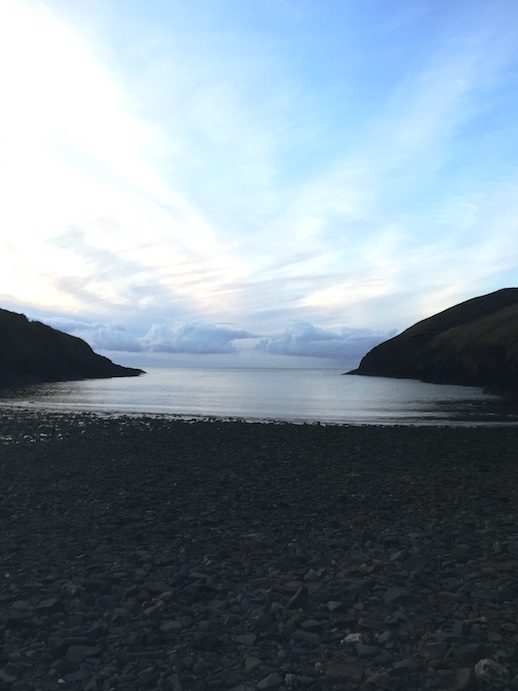…In which, as the year comes to its end, our friends and collaborators look back on the past twelve months and share their moments;
This year I have spent much of my time in the northernmost corner of Pembrokeshire, around three miles from the Teifi estuary, the county’s natural border with neighbouring Ceredigion. On certain days it is possible to look out on the estuary and see a crosshatched line in the waves, as though someone had attempted to draw a line in the water marking the point where the Teifi reaches the sea. When out in my friends’ small boat, even on still summer evenings, these diverging currents were always a presence, one accompanied by a strong sense of the need to make a decision. On one side of the hull lay the infinite Irish Sea, on the other, the rocks and headland of the estuary. The omnipresent churn on which our boat was buffeted now seems as apt a metaphor as any for 2016.
In the 18th Century the estuary was busy with traffic, principally boats laden with slate sailing downstream from the town of Cardigan, which then, locals will tell you, was the slate capital of Britain. Nearly all the houses in the village I stay in and throughout this part of West Wales share a similar design in their house sign. The signs are always in slate, always in capitals and usually in Cymraeg (Welsh) but share little grammatical consistency. For example, the sign attached to our neighbours’ house ‘SWN-Y-MWNT’ is hyphenated, whereas ‘SWN Y NANT’ a bungalow further down the hill, is written in plain text. I am unfamiliar with the name of the ubiquitous font in which the signs are rendered, but Holiday Cottage Sans Serif, or Gill Sans Second Home would certainly suffice.
In my childhood the font used locally for most homes was Amorican Uncial, a curved Gallic script one might associate with various editions of Lord of The Rings, or the signage on the first generation of health food shops and craft centres that flourished in Pembrokeshire during the late 1970s, when I first visited as a child. The Incredible String band wrote much of The Hangman’s Beautiful Daughter in a valley behind the nearby mountain of Carn Ingli, which was also a destination for the generation interested in self-sufficiency, who frequently visited the home of the movement’s founding father, John Seymour, situated half way towards its peak. They were drawn as well to the standing stones at Pentre Ifan that predate Stonehenge and the sense of being in the far West, so close to the sea and at the edge of everything.
There are fewer of those people here now. To my incredulity, I am no longer certain if Amorican Uncial existed. Although a classicist friend of the family taught me the phrase, the only similar font I have found online is American Uncial. Issues of authenticity have been a wearying and enduring feature of the year.
John Knapp-Fisher was a water-colourist who moved to Pembrokeshire in the 1960s. In a similar manner to the way in which Ben Nicholson captured the light in St Ives, Knapp-Fisher’s smudges of very dark grey and cream evoke a particular atmosphere, the moments here when the mist sets in and any distinction between the white stone buildings and the sullen waves is lost. Although never especially treacherous there are days here when the cliff top paths are dissolved by clouds.
A local picture framer remarked to me recently that since his death, Knapp Fisher’s work has become almost collectible, although he couldn’t confirm whether watercolours he had seen for sale had achieved their listed price. Perhaps the paintings will remain in Pembrokeshire and hang on the walls as interior furnishings in the smarter holiday cottages, as an accompaniment to the slate signs hung near their entrances. Knapp-Fisher was not a native West Walian, nor were the hippies visiting the stone circles and burial mounds who decided to stay on and open the health food shops, nor, presumably, was the person who coined the term Amorican Uncial, nor indeed, am I. The landscape and its population alter through the decades. The sea has partially eroded the cliffs I walked on as a child, the local school where lessons were taught in Cymraeg closed at the turn of the century.
As the coastline falls well within the boundary of the Pembrokeshire National Park, timelessness is nevertheless maintained. It’s difficult to convey the exhilaration of walking alongside the sea as it is bathed in sunlight in this quiet, slow place; or on grey afternoons when the wind is up and the waves pummel the rocks with a ferocity that sends their spray upwards, high over the cliff face, to land on the grass banks as large drops of white rain.
To deny the privilege and joy of these experiences would be ridiculous, even grotesque. But as this turbulent, often wretched year draws to a close, I’m struck by the need to turn outwards, away from the subconscious and its frequently flattering relationship with nature. Time spent in the gentle wilderness of places such as North Pembrokeshire is certainly nourishing, reconnecting us as it does with what we like to imagine is our better self. In 2017 perhaps our energy might be more usefully directed towards gazing deeply into the darkness, in order to rediscover the means with which to restore the light.
Richard King on Caught by the River / on Twitter
